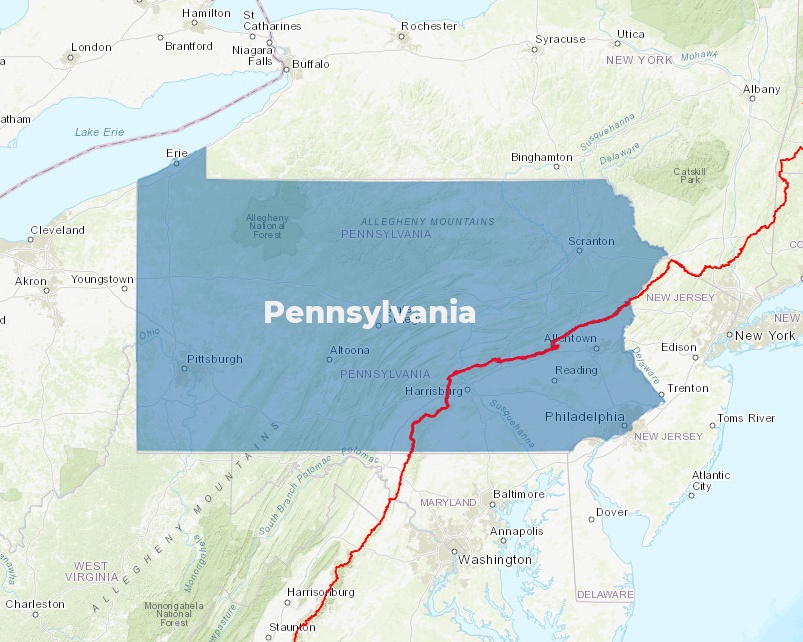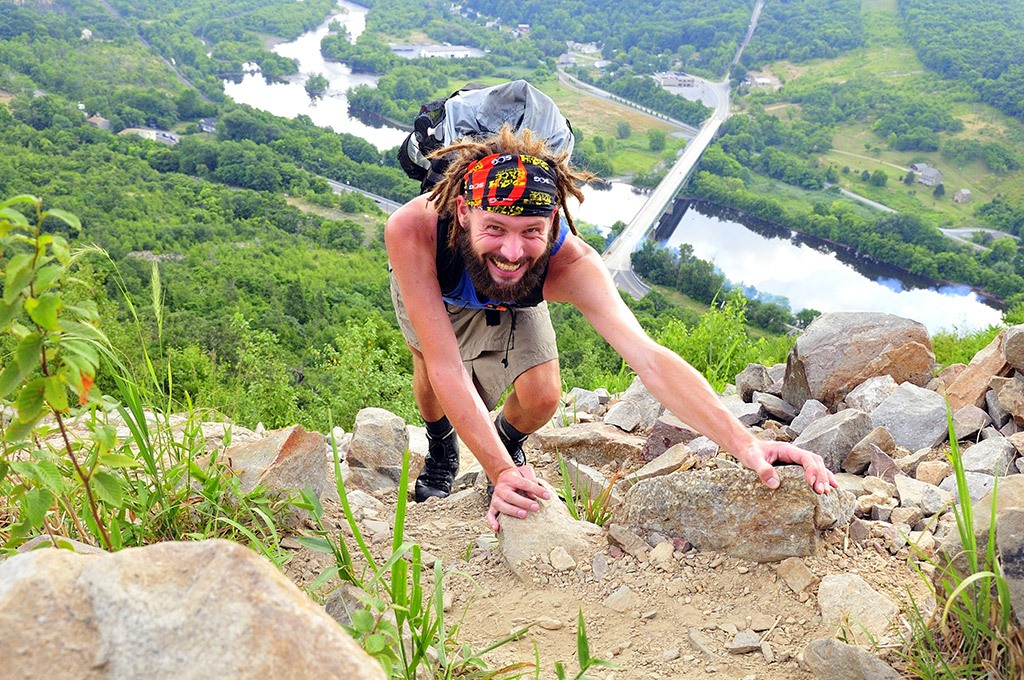A.T. Miles in State
Easy to Challenging
Elevation Range in Feet
 The A.T. in Pennsylvania plays an important role in showcasing America’s heritage and the state’s sweeping landscapes, passing historic landmarks and ascending to scenic heights along Kittatinny Ridge.
The A.T. in Pennsylvania plays an important role in showcasing America’s heritage and the state’s sweeping landscapes, passing historic landmarks and ascending to scenic heights along Kittatinny Ridge.
Pennsylvania’s nickname is “Rocksylvania,” but it’s not all rocks. The A.T. in Pennsylvania is famed for its rocky terrain, especially on the long, flat ridges north of the Susquehanna River. The southern part of the state offers some of the gentlest, smoothest terrain of the entire A.T., including the Cumberland Valley. Other highlights are the A.T. Museum in Pine Grove State Park (home to the “half gallon challenge near the Trail’s mid-point) and the charming town of Boiling Springs, which houses ATC’s mid-Atlantic office. Flat, rocky ridges broken by steep descents to rivers and gaps characterize the A.T. north of the Susquehanna.
The A.T. passes through game lands managed for hunting, so fall is not the best time to go.
All hunters and non-hunters are required to wear at least 250 square inches of fluorescent orange material on the head, chest and back combined, or a fluorescent orange hat, from Nov. 15 to Dec. 15 (except on Sundays) on state game lands in Pennsylvania (much of the A.T. between the and Delaware Water Gap (roughly the northern 2/3 of the state). For more information about hunting safety along the A.T. visit www.appalachiantrail.org/hunting.
Only thru-hikers (defined as those “walking the Appalachian Trail from point of beginning to an exit, which is not the place of beginning) may camp on Pennsylvania Game Commission lands, and these hikers must camp within 200 ft of A.T., at least 500 ft from a stream or spring.
In addition, camping regulations vary considerably throughout the state, so be sure to plan ahead for your hike.

The Potomac Appalachian Trail Club (PATC) has enhanced the mid-Atlantic outdoor experience since 1927, including 240 miles of the Appalachian Trail in Virginia, West Virginia, Maryland and Pennsylvania. The PATC maintains trails, shelters and cabins, and they make maps and guidebooks for outdoor adventurers. Learn more and become a member today at patc.net.
Keystone Trails Association is a volunteer organization dedicated to providing, preserving, protecting and promoting hiking trails and hiking opportunities in Pennsylvania. We represent and advocate the interests and concerns of the Pennsylvania hiking community. Do you hike in PA? Consider joining KTA today!

The oldest hiking club in Maryland (since 1934) and the premier hiking group in the state. We are a Baltimore-based volunteer organization that is centered on hiking. We support Leave No Trace principles, work on local trails and on the nation’s first National Scenic Trail, the Appalachian Trail. We organize and lead hikes and other outdoor activities, such as camping, seasonal canoe trips and backpacking weekends. We offer seasonal canoe trips and backpacking ventures. We have a year-round schedule with hikes in local parks and paths, in State Parks, National Parks, National Forests, and sites in and around Maryland, Pennsylvania, Virginia, West Virginia, New Jersey and Delaware. Learn more and become a member today at mcomd.org.

CVATC members maintain the seventeen miles of the Appalachian Trail in Cumberland County, Pennsylvania. The trail was once a road walk that was transformed into the trail we know today. This trail section begins at Center Point Knob (originally the half-way point on the Appalachian Trail) on South Mountain and extends through the Cumberland Valley between Carlisle and Mechanicsburg to the top of Blue Mountain. Learn more and become a member today at cvatclub.org.
York Hiking Club maintains a 13-mile section of the Appalachian Trail on Blue Mountain and a 7.5 mile section north of Harrisburg, Pa. Learn more and become a member today at yorkhikingclub.com.

SATC volunteers contribute at least 2000 hours each year toward the care and preservation of a 20-mile section of the A.T. from PA-225 on Peters Mountain north to Rausch Gap. SATC volunteers also maintain the Peters Mountain shelter, the privy, monitor and protect the Trail corridor, develop management plans for our Trail section, are caretakers for several access parking lots, and maintain the Darlington Trail as well as several side trails to the A.T. Learn more and become a member today at satc-hike.org.

The club is sponsored by the Allentown Recreation Bureau and is a member of the Keystone Trail Association and the Appalachian Trail Conference. We maintain 10.3 miles of the Appalachian Trail, including two backcountry shelters, Allentown (north of New Tripoli) and G.W. Outerbridge (west of the Lehigh Gap).Learn more and become a member today at allentownhikingclub.org.
Club members and other volunteers perform on-going maintenance, clean-ups and repairs on the Appalachian Trail, Shelters, Arboretum, and various other projects throughout the year. Learn more and become a member today at bmecc.org.
Founded in 1876, the Appalachian Mountain Club promotes the protection, enjoyment, and understanding of the mountains, forests, waters, and trails of America’s Northeast and Mid-Atlantic regions. Learn more and become a member today at amcdv.org.
BATONA (BAck TO NAture) is a Philadelphia based hiking club providing hiking and trail maintenance activities in Philadelphia; surrounding counties of Pennsylvania, New Jersey, and Delaware; and beyond. Learn more and become a member today at batona.wildapricot.org.
 New York-New Jersey Trail Conference
New York-New Jersey Trail ConferenceThe New York-New Jersey Trail Conference is a volunteer-powered organization that builds, maintains, and protects public trails. Together with our partners, we strive to ensure that the trails and natural areas we share are sustainable and accessible for all to enjoy for generations to come. For more information and to get involved today, www.nynjtc.org.

The Appalachian Trail Conservancy is always looking for dedicated volunteers to help maintain the A.T. and assist in our visitor centers and headquarters. Opportunities range from greeting visitors and providing information about local hikes to joining a Trail crew for week-long maintenance trips, gaining first-hand experience in what it takes to keep the A.T. open and enjoyable for millions each year. Learn more at appalachiantrail.org/volunteer.

